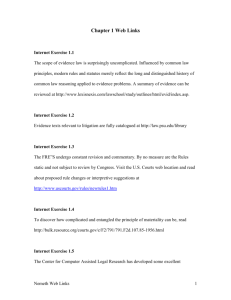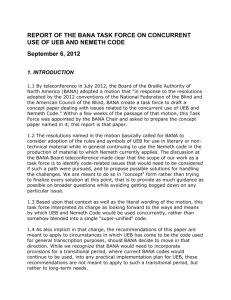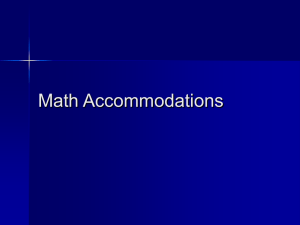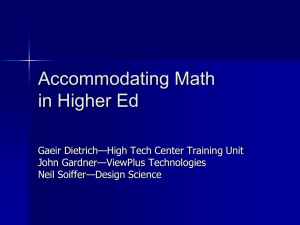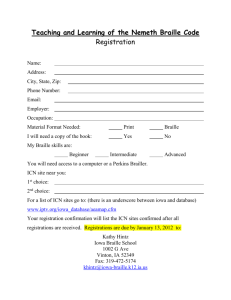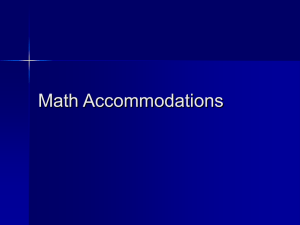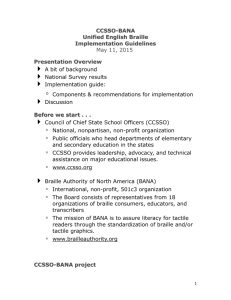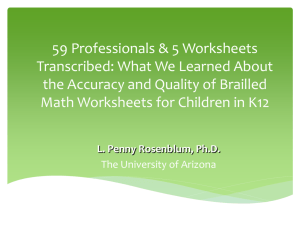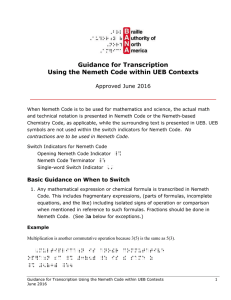Provisional Guidance for Transcription Using the Nemeth Code within UEB Contexts
advertisement
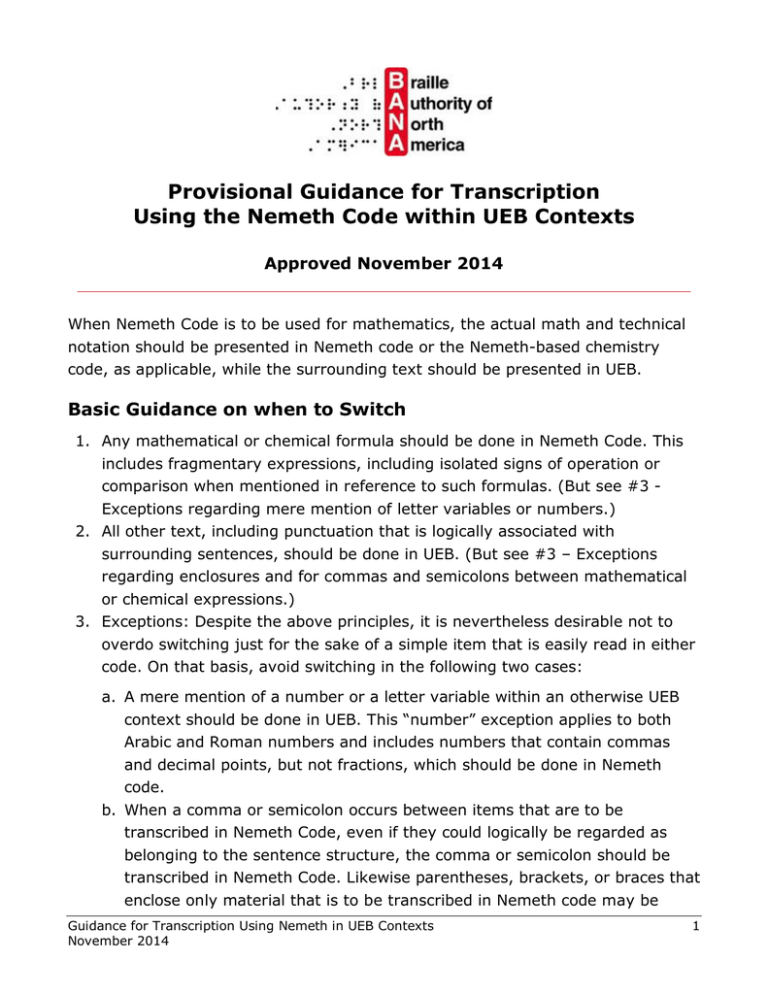
Provisional Guidance for Transcription Using the Nemeth Code within UEB Contexts Approved November 2014 When Nemeth Code is to be used for mathematics, the actual math and technical notation should be presented in Nemeth code or the Nemeth-based chemistry code, as applicable, while the surrounding text should be presented in UEB. Basic Guidance on when to Switch 1. Any mathematical or chemical formula should be done in Nemeth Code. This includes fragmentary expressions, including isolated signs of operation or comparison when mentioned in reference to such formulas. (But see #3 Exceptions regarding mere mention of letter variables or numbers.) 2. All other text, including punctuation that is logically associated with surrounding sentences, should be done in UEB. (But see #3 – Exceptions regarding enclosures and for commas and semicolons between mathematical or chemical expressions.) 3. Exceptions: Despite the above principles, it is nevertheless desirable not to overdo switching just for the sake of a simple item that is easily read in either code. On that basis, avoid switching in the following two cases: a. A mere mention of a number or a letter variable within an otherwise UEB context should be done in UEB. This “number” exception applies to both Arabic and Roman numbers and includes numbers that contain commas and decimal points, but not fractions, which should be done in Nemeth code. b. When a comma or semicolon occurs between items that are to be transcribed in Nemeth Code, even if they could logically be regarded as belonging to the sentence structure, the comma or semicolon should be transcribed in Nemeth Code. Likewise parentheses, brackets, or braces that enclose only material that is to be transcribed in Nemeth code may be Guidance for Transcription Using Nemeth in UEB Contexts November 2014 1 transcribed as part of that material even if they could logically be considered as belonging to the larger sentence structure. 4. To avoid use of switch indicators when a single word standing alone occurs between two math expressions, a one-word switch indicator (6, 3) may be used in Nemeth mode to indicate that the following word is in UEB. Contractions may be used in the subsequent word. The one-word switch indicator should precede the word whether or not it contains contractions. Otherwise, no contractions are used in Nemeth mode. Similar to the capital indicators, the one-word switch indicator is disregarded for purposes of the UEB lower-sign rule. (NOTE: This symbol is experimental and has not yet been put forward by the BANA Mathematics Braille Technical Committee, which is responsible for changes to dot constructions in Nemeth mode). 5. A switch from Nemeth to UEB or from UEB to Nemeth terminates the effect of typeform and capitalization indicators without the need for explicit terminators. UEB Rule for Use of Opening and Closing Nemeth Indicators The opening and closing Nemeth indicators should be used to indicate the switch in and out of Nemeth mode. For convenience, the applicable section of the Rules of Unified English Braille 2013 is inserted here: 14.6 Nemeth Code within UEB text 14.6.1 When technical material is transcribed according to the provisions of The Nemeth Braille Code for Mathematics and Science Notation within UEB text, the following sections provide for switching between UEB and Nemeth Code. 14.6.2 Place the opening Nemeth Code indicator followed by a space before the sequence to which it applies. Its effect is terminated by the Nemeth Code terminator preceded by a space. Note: The spaces required with the indicator and the terminator do not represent spaces in print. Guidance for Transcription Using Nemeth in UEB Contexts November 2014 2 Examples: The result will be in the form (ax + by)(cx +dy), where ac = 12, bd = −10, and ad + bc = 7. ,! result w 2 9 ! =m _% ··(ax+by)(cx+dy) _:1 ": _% ··ac .k #12, bd .k -#10 _:1 & _% ··ad+bc .k #7 _:4 He said, "4x+3y is the numerator." ,he sd1 8_% #4x+3y _: is ! ··num]ator40 14.6.3 When the Nemeth Code text is displayed on one or more lines separate from the UEB text, the opening Nemeth Code indicator and the Nemeth Code terminator may each be placed on a line by itself or at the end of the previous line of text. Example: Solution. Again we group the first two terms and the last two terms. 4x3 − 12x2 − x + 3 = 4x2(x − 3) − (x − 3) = (x − 3)(4x2 − 1) = (x − 3)(2x + 1)(2x − 1) ··.1,solu;n4 ,ag we gr\p ! f/ two t]ms & ! la/ two t]ms4 _% ··#4x^3"-12x^2"-x+3 ····.k #4x^2"(x-3)-(x-3) ····.k (x-3)(4x^2"-1) ····.k (x-3)(2x+1)(2x-1) _: Guidance for Transcription Using Nemeth in UEB Contexts November 2014 3 Below are the examples from the UEB codebook modified as per the guidelines proposed in this document. Included changes are: keeping the open/close Nemeth indicators on the line with the equation if the entire equation and indicators will fit on the line; not leaving Nemeth code for the word “and” or “where.” Examples: The result will be in the form (ax + by)(cx +dy), where ac = 12, bd = −10, and ad + bc = 7. ··,! result w 2 9 ! =m _% (ax+by)(cx+dy), ,'": ac .k #12, bd .k -#10 ,'& ad+bc .k #7 _:4 He said, "4x+3y is the numerator." [No change] ,he sd1 8_% #4x+3y _: is ! num]ator40 Solution. Again we group the first two terms and the last two terms. 4x3 − 12x2 − x + 3 = 4x2(x − 3) − (x − 3) = (x − 3)(4x2 − 1) = (x − 3)(2x + 1)(2x − 1) ··.1,solu;n4 ,ag we gr\p ! f/ two t]ms & ! la/ two t]ms4 _% ··#4x^3"-12x^2"-x+3 ····.k #4x^2"(x-3)-(x-3) ····.k (x-3)(4x^2"-1) ····.k (x-3)(2x+1)(2x-1) _: [The opening indicator is placed at the end of the text line preceding the beginning of the math expression in preference to being on a line by itself.] Guidance for Transcription Using Nemeth in UEB Contexts November 2014 4 Additional Guidelines 1. The title page and any supplemental title pages of a book are transcribed in UEB. 2. The transcriber should look through the entire book and make decisions about how the switches will be handled before beginning the transcription so that there is consistency throughout the book. For special symbols such as the percent sign, degree mark, and mentions of Greek letters, the transcriber should, when consistency of representation is seen to be especially beneficial to the reader, switch to Nemeth Code for such symbols (along with any attached numbers) when the same symbol occurs in nearby math notation, even though the local context does not constitute math notation. 3. Labels for figures (such as “Figure 1”) should be transcribed in UEB. 4. In a numbered or lettered series of math problems that are in Nemeth code, leave Nemeth mode in effect for the identifiers to avoid excessive switching, even though these identifiers are not technically part of the math. Example: a. 2 5 b. 12 c. 14 5 -9= d. 2 24 + = 5 2 5 9 -5= 8 + = 15 15 _% ;A_4 ;B_4 ;C_4 ;D_4 ?2/5#+?5/2# .K = ?12/5#-?9/5# .K = ?14/5#-?8/9# .K = ?2/15#+?24/15# .K = _: 5. In general, keep the switch indicators on the same line as the mathematics to which they apply with the following exceptions: a. As shown in the example above, the opening Nemeth Code indicator at the beginning of a list of numbered or lettered identifiers should be placed by itself on the line above the first item. This ensures that all identifiers begin Guidance for Transcription Using Nemeth in UEB Contexts November 2014 5 in the same cell. If space permits, the Nemeth Code terminator should still be placed on the same line with the text where Nemeth mode ends. b. If space permits, an opening Nemeth Code indicator that precedes a spatial problem may be placed on the same line with the end of the text above the problem. The required blank line follows the opening Nemeth Code indicator. If there is not room on the line with the preceding text, the opening Nemeth Code indicator is placed at the margin on a line by itself and followed by the requisite blank line. When Nemeth mode is closed after a spatial problem, the Nemeth Code terminator is placed at the margin on a line by itself and is preceded by the required blank line (the blank lines around spatial problems are done in Nemeth mode). c. If code switching occurs within a math problem and would interfere with the alignment of the problem, an opening Nemeth Code indicator may be placed at the end of the line before the math to which it applies. If there is not room on the line, the indicator is treated as a runover to that line. 6. If exercise directions end with an expression in Nemeth code and the subsequent math problem starts with Nemeth code, Nemeth mode may be left in effect between the end of the directions and the start of the problem. 7. If a tactile graphic intervenes between two items in Nemeth code, leave Nemeth mode in effect for the graphic. When applicable, place a note on the transcriber’s notes page indicating that Nemeth Code is used in tactile graphics. 8. When short comments in words appear alternated with math problems (such as comments on equations), switch out of Nemeth code to transcribe the comments in contracted braille. 9. In uncontracted Nemeth braille, the English Letter Indicator (ELI) is used wherever required by §24-§30 of the Nemeth Code. It would mean, for example, that multiple choice and exercise letters as well as single letter abbreviations would need the ELI. 10. UEB emphasis indicators are used in the surrounding text, and Nemeth emphasis indicators are used only if it is necessary to indicate emphasis inside the Nemeth code switches. 11. If code switching is necessary within the text of an emphasized passage as, for example, in a labeled statement, the beginning emphasis indicators are repeated after each switch to show that emphasis continues (See #5 under Basic Guidance on When to Switch). Therefore, to avoid excessive use of Guidance for Transcription Using Nemeth in UEB Contexts November 2014 6 indicators, omit the emphasis indication from an emphasized passage in which code switching occurs unless doing so would change the meaning. Formatting The switch indicators signal which symbols are to be used, but they do not govern the formatting. Formatting (that is, indentions, line spacing, centering, etc.) is handled as a separate issue from the switch between symbols sets/notation. This means that the document is formatted according to the following mix of Nemeth Code and Braille Formats provisions regardless of whether Nemeth mode is in effect. Note that for this context, emphasis falls in the category of symbols, not formatting. 1. Follow Nemeth Code rules about division of mathematical expressions. If there is not room on a line for the Nemeth Code terminator and any related punctuation to follow the last expression, the indicator may be separated from the math and placed on the following line. 2. For a box transcribed all in Nemeth Code, the begin box line may include an opening Nemeth Code indicator followed by a space at the beginning of the line. For the end box line, a Nemeth Code terminator appears at the end of the closing box line. The box lines themselves should be brailled as indicated in the most current edition of Braille Formats. If a transcriber’s note occurs inside a box that is otherwise all in Nemeth Code, do not include the box lines within Nemeth mode. 3. All narrative paragraphs should be transcribed in 3-1 (no blocked paragraphs). 4. Runover margins for itemized material are determined individually for each question rather than by section as Formats states. 5. Author’s comments following mathematical equations are treated as part of the line of the equation, with runovers in the appropriate location for the expression. Guidance for Transcription Using Nemeth in UEB Contexts November 2014 7 Example: You can substitute these values into the equation to find C. Ax + By = C 4x + 5y = C 4(3) + 5(1) = C 12 + 5 = C 17 = C Standard form of a linear equation Substitute values for A and B. Substitute values for x and y. The standard form of the equation is 4x + 5y = 17. ··,y c sub/itute ~! values 9to ! equa;n to f9d ;,c4 _% ··,ax+,by .k ,c _: ,/&>d =m ( a l9e> ····equa;n _% ··#4x+5y .k ,c _: ,sub/itute values = ,a ····& ;,b4 _% ··#4(3)+5(1) .k ,c _: ,sub/itute values ····= ;x & ;y4 _% ··#12+5 .k ,c ··#17 .k ,c _: ,! /&>d =m ( ! equa;n is _% #4x+5y .k #17 _:4 6. Follow Formats for displayed literary text, with the exception of blocked paragraphs, which are not used in Nemeth. Follow Nemeth rules for displayed math expressions (displayed material begins 2 cells to the right of the material above it with runovers two cells to the right of that; no blank lines). 7. Instructions are transcribed in 5-3 (follows Nemeth formatting rules). At least one line of the instructions must be on the same braille page as the questions that follow. 8. Instructions must be followed by lettered or numbered exercises. If there are no exercises following the instructions, the text is considered a narrative paragraph and transcribed in 3-1. 9. For an exercise with any number of subentry levels, use margins 1-5 for the first level, and 3-5 for all subsequent levels. (follows Nemeth). Guidance for Transcription Using Nemeth in UEB Contexts November 2014 8 10. If the body of a table, including row headings, consists only of numbers, the numeric indicator may be omitted. No TN is required. The whole table is done according to Nemeth and must be within Nemeth switches. 11. In listed table format, when transcribing within the Nemeth switches, a double dash (four cells of dots 36) is used for blank entries that are to be filled in. 12. Use analogy symbols according to the rules of Nemeth Code. 13. In a technical context, use the Nemeth caret; in surrounding text, use the UEB caret. 14. Words enclosed in shapes are transcribed according to the methods for shapes with internal modification and must be enclosed within Nemeth switches. Guidance for Transcription Using Nemeth in UEB Contexts November 2014 9
